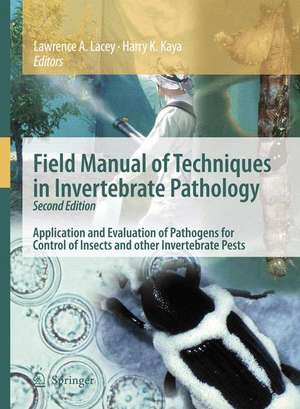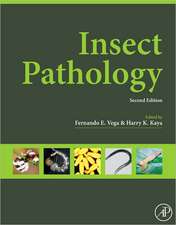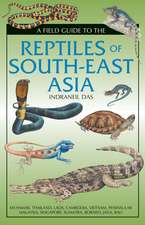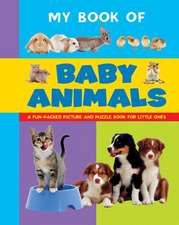Field Manual of Techniques in Invertebrate Pathology: Application and Evaluation of Pathogens for Control of Insects and other Invertebrate Pests
Editat de Lawrence A. Lacey, Harry K. Kayaen Limba Engleză Hardback – 4 oct 2007
| Toate formatele și edițiile | Preț | Express |
|---|---|---|
| Paperback (1) | 1131.17 lei 38-44 zile | |
| SPRINGER NETHERLANDS – 4 oct 2007 | 1131.17 lei 38-44 zile | |
| Hardback (1) | 1142.12 lei 38-44 zile | |
| SPRINGER NETHERLANDS – 4 oct 2007 | 1142.12 lei 38-44 zile |
Preț: 1142.12 lei
Preț vechi: 1502.79 lei
-24% Nou
Puncte Express: 1713
Preț estimativ în valută:
218.57€ • 237.34$ • 183.60£
218.57€ • 237.34$ • 183.60£
Carte tipărită la comandă
Livrare economică 18-24 aprilie
Preluare comenzi: 021 569.72.76
Specificații
ISBN-13: 9781402059315
ISBN-10: 1402059310
Pagini: 868
Ilustrații: XVIII, 868 p.
Dimensiuni: 195 x 260 x 40 mm
Greutate: 2.21 kg
Ediția:2nd ed. 2007
Editura: SPRINGER NETHERLANDS
Colecția Springer
Locul publicării:Dordrecht, Netherlands
ISBN-10: 1402059310
Pagini: 868
Ilustrații: XVIII, 868 p.
Dimensiuni: 195 x 260 x 40 mm
Greutate: 2.21 kg
Ediția:2nd ed. 2007
Editura: SPRINGER NETHERLANDS
Colecția Springer
Locul publicării:Dordrecht, Netherlands
Public țintă
ResearchCuprins
to microbial control.- Theory and practice of microbial insecticide application.- Statistical Considerations.- Experimental design: statistical considerations and analysis.- Application Equipment.- Ground-based application equipment.- Conventional application equipment: aerial application.- Dissemination of beneficial microbial agents by insects.- Overview of Pathogen Groups.- Viruses.- Bacteria.- Entomopathogenic microsporidia.- Fungi.- Nematodes.- Naturally Occurring Pathogens.- Documentation of naturally occurring pathogens and their impact in agroecosystems.- Assessing impact of naturally occurring pathogens of forest insects.- Exotic Pathogens.- of exotic pathogens and documentation of their establishment and impact.- Evaluation of Entomopathogens in Specific Systems.- Application and evaluation of entomopathogens in potato.- Application and evaluation of entomopathogens in crucifers and cucurbits.- Microbial control of insect pests of corn.- Evaluation of microbial agents against rice pests.- Microbial control of insect pests of soybean.- Microbial insecticide application and evaluation: Cotton.- Mushroom pests.- Techniques for testing microbials for control of arthropod pests in greenhouses.- Forest defoliators.- Microbial control of wood-boring insects attacking forest and shade trees.- Microbial control of lepidopteran pests of apple orchards.- Microbial control of insect pests of stone fruit and nut crops.- Application and evaluation of entomopathogens for citrus pest control.- Small fruits.- Application and evaluation of entomopathogens for control of pest insects in mint.- Insect and Mite Control on Nursery and Landscape Plants with Entomopathogens.- Grasshoppers and locusts.- Lawn, turf and grassland pests.- Application and evaluation of entomopathogens formanaging insects in stored products.- Microbial control of urban pests – cockroaches, ants and termites.- Application and evaluation of entomopathogens for control of livestock and poultry pests.- Microbial control of mosquitoes and black flies.- Terrestrial mollusc pests.- Transgenic Plants.- Evaluating transgenic plants for suitability in pest and resistance management programs.- Resistance.- Resistance to insect pathogens and strategies to manage resistance: An update.- Non-target Organisms.- Guidelines for evaluating effects of entomopathogens on non-target organisms.
Recenzii
From the reviews of the second edition:
"This paperback volume updates and expands the information presented in Lacey and Kaya's first hardcore edition ... . The book is very well-edited ... . The index is very complete and increases the utility of the book. Overall, the Field Manual of Techniques in Invertebrate Pathology is an excellent book and an important reference volume for researchers and practitioners in the field of pest management. ... It will serve as a useful resource for researchers and students of specific pathogen groups ... ." (Mary Barbercheck, Entomologia Experimentalis et Applicata, Vol. 129, 2008)
"You will want to examine the second edition of Field Manual of Techniques in Invertebrate Pathology if you evaluate entomopathogens in the field or examine their environmental impact. This landmark invertebrate pathology manual has been considerably enhanced and updated. The manual is written for researchers, graduate students, and Integrated Pest Management (IPM) practitioners. ... all of the chapters have been -updated. The Tables are larger and easier to read. Many of the figures are crisper and updated." (Timothy J. Kurtti, Crop Protection, Vol. 27, 2008)
"This paperback volume updates and expands the information presented in Lacey and Kaya's first hardcore edition ... . The book is very well-edited ... . The index is very complete and increases the utility of the book. Overall, the Field Manual of Techniques in Invertebrate Pathology is an excellent book and an important reference volume for researchers and practitioners in the field of pest management. ... It will serve as a useful resource for researchers and students of specific pathogen groups ... ." (Mary Barbercheck, Entomologia Experimentalis et Applicata, Vol. 129, 2008)
"You will want to examine the second edition of Field Manual of Techniques in Invertebrate Pathology if you evaluate entomopathogens in the field or examine their environmental impact. This landmark invertebrate pathology manual has been considerably enhanced and updated. The manual is written for researchers, graduate students, and Integrated Pest Management (IPM) practitioners. ... all of the chapters have been -updated. The Tables are larger and easier to read. Many of the figures are crisper and updated." (Timothy J. Kurtti, Crop Protection, Vol. 27, 2008)
Textul de pe ultima copertă
The Field Manual of Techniques in Invertebrate Pathology is designed to provide background and instruction on a broad spectrum of techniques and their use in the evaluation of entomopathogens in the field. The second edition of the Field Manual provides updated information and includes two additional chapters and 12 new contributors. The intended audience includes researchers, graduate students, practitioners of integrated pest management (IPM), regulators and those conducting environmental impact studies of entomopathogens. Although it can function as a stand alone reference, the Field Manual is complementary to the laboratory oriented Manual of Techniques in Insect Pathology and to comprehensive texts in insect pathology.
The Editors have structured the 40 chapters of the Field Manual into 10 sections to provide the tools required for planning experiments with entomopathogens and their implementation in the field. The basic tools include chapters on the theory and practice of application of microbial control agents (MCAs) (Section I), statistical considerations in the design of experiments (Section II), and three chapters on application equipment and strategies (Section III). Section IV includes individual chapters on the major pathogen groups (virus, bacteria, microsporidia, fungi, and nematodes) and special considerations for their evaluation under field conditions. This section sets the stage for subsequent chapters on the impact of naturally occurring and introduced exotic pathogens and inundative application of MCAs. Twenty-three chapters on the application and evaluation of MCAs in a wide variety of agricultural, forest, domestic and aquatic habitats comprise Section VII of the Field Manual. In addition to insect pests, the inclusion of mites and slugs broadens the scope of the book. Most of the chapters in this section include step by step instructions on handling of inoculum, design of fieldexperiments and experimental plots and application and assessment of efficacy of dozens of MCAs. Several of these chapters include supplementary techniques and media for conducting follow up laboratory studies for confirmation of infection, determination of persistence, etc. The three final chapters include: special consideration for evaluation of Bt transgenic plants (Section VIII); resistance to insect pathogens and strategies to manage resistance (Section IX); and guidelines for evaluating effects of MCAs on nontarget organisms (Section X).
Due to uncertainty regarding the future availability of organophosphate and other conventional chemical insecticides, MCAs will play increasingly important roles in IPM. The Field Manual will provide researchers and IPM practitioners with techniques and practical guidance for the study and optimal use of MCAs in a variety of settings.
The Editors have structured the 40 chapters of the Field Manual into 10 sections to provide the tools required for planning experiments with entomopathogens and their implementation in the field. The basic tools include chapters on the theory and practice of application of microbial control agents (MCAs) (Section I), statistical considerations in the design of experiments (Section II), and three chapters on application equipment and strategies (Section III). Section IV includes individual chapters on the major pathogen groups (virus, bacteria, microsporidia, fungi, and nematodes) and special considerations for their evaluation under field conditions. This section sets the stage for subsequent chapters on the impact of naturally occurring and introduced exotic pathogens and inundative application of MCAs. Twenty-three chapters on the application and evaluation of MCAs in a wide variety of agricultural, forest, domestic and aquatic habitats comprise Section VII of the Field Manual. In addition to insect pests, the inclusion of mites and slugs broadens the scope of the book. Most of the chapters in this section include step by step instructions on handling of inoculum, design of fieldexperiments and experimental plots and application and assessment of efficacy of dozens of MCAs. Several of these chapters include supplementary techniques and media for conducting follow up laboratory studies for confirmation of infection, determination of persistence, etc. The three final chapters include: special consideration for evaluation of Bt transgenic plants (Section VIII); resistance to insect pathogens and strategies to manage resistance (Section IX); and guidelines for evaluating effects of MCAs on nontarget organisms (Section X).
Due to uncertainty regarding the future availability of organophosphate and other conventional chemical insecticides, MCAs will play increasingly important roles in IPM. The Field Manual will provide researchers and IPM practitioners with techniques and practical guidance for the study and optimal use of MCAs in a variety of settings.
Caracteristici
Provides researchers, IPM practitioners, and graduate students with techniques and practical guidance for the study and optimal use of invertebrate pathogens in a variety of settings Covers many topics including the theory and practice of microbial insecticide application, experimental design, ground based and aerial application equipment, overviews of the individual of pathogen groups, classical biological control, transgenic plants, resistance to insect pathogens, and guidelines for evaluating pathogens on non-target organisms The only book on the market that offers diverse theoretical and practical aspects of application and evaluation of invertebrate pathogens for control of invertebrate pests (insects, mites, mollusks) in a variety of agroecosystems, in public health, and against ornamental, urban and veterinary pests Provides step by step procedures written by an international group of experts for the use of invertebrate pathogens in pest control and furnishes the tools required for planning experiments and for the implementation of control programs









